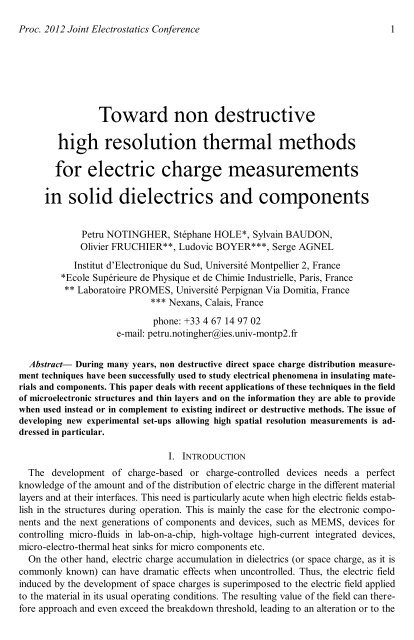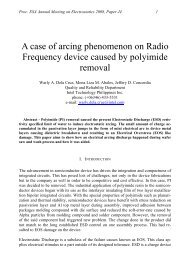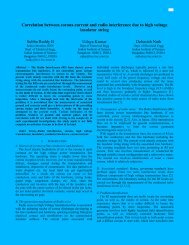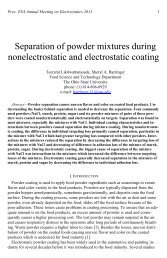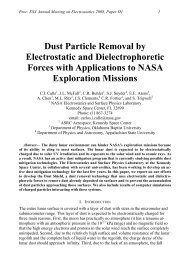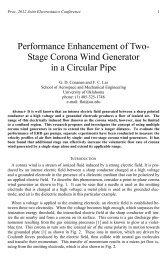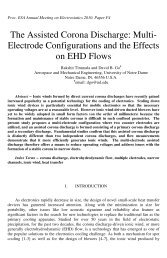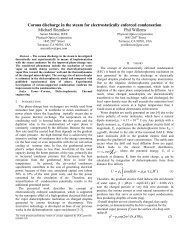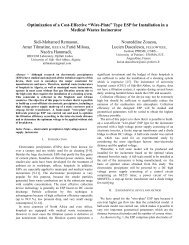Toward non destructive high resolution thermal methods for electric ...
Toward non destructive high resolution thermal methods for electric ...
Toward non destructive high resolution thermal methods for electric ...
Create successful ePaper yourself
Turn your PDF publications into a flip-book with our unique Google optimized e-Paper software.
Proc. 2012 Joint Electrostatics Conference 1<strong>Toward</strong> <strong>non</strong> <strong>destructive</strong><strong>high</strong> <strong>resolution</strong> <strong>thermal</strong> <strong>methods</strong><strong>for</strong> <strong>electric</strong> charge measurementsin solid di<strong>electric</strong>s and componentsPetru NOTINGHER, Stéphane HOLE*, Sylvain BAUDON,Olivier FRUCHIER**, Ludovic BOYER***, Serge AGNELInstitut d’Electronique du Sud, Université Montpellier 2, France*Ecole Supérieure de Physique et de Chimie Industrielle, Paris, France** Laboratoire PROMES, Université Perpignan Via Domitia, France*** Nexans, Calais, Francephone: +33 4 67 14 97 02e-mail: petru.notingher@ies.univ-montp2.frAbstract— During many years, <strong>non</strong> <strong>destructive</strong> direct space charge distribution measurementtechniques have been successfully used to study <strong>electric</strong>al phenomena in insulating materialsand components. This paper deals with recent applications of these techniques in the fieldof microelectronic structures and thin layers and on the in<strong>for</strong>mation they are able to providewhen used instead or in complement to existing indirect or <strong>destructive</strong> <strong>methods</strong>. The issue ofdeveloping new experimental set-ups allowing <strong>high</strong> spatial <strong>resolution</strong> measurements is addressedin particular.I. INTRODUCTIONThe development of charge-based or charge-controlled devices needs a perfectknowledge of the amount and of the distribution of <strong>electric</strong> charge in the different materiallayers and at their interfaces. This need is particularly acute when <strong>high</strong> <strong>electric</strong> fields establishin the structures during operation. This is mainly the case <strong>for</strong> the electronic componentsand the next generations of components and devices, such as MEMS, devices <strong>for</strong>controlling micro-fluids in lab-on-a-chip, <strong>high</strong>-voltage <strong>high</strong>-current integrated devices,micro-electro-<strong>thermal</strong> heat sinks <strong>for</strong> micro components etc.On the other hand, <strong>electric</strong> charge accumulation in di<strong>electric</strong>s (or space charge, as it iscommonly known) can have dramatic effects when uncontrolled. Thus, the <strong>electric</strong> fieldinduced by the development of space charges is superimposed to the <strong>electric</strong> field appliedto the material in its usual operating conditions. The resulting value of the field can there<strong>for</strong>eapproach and even exceed the breakdown threshold, leading to an alteration or to the
Proc. 2012 Joint Electrostatics Conference 2destruction of the material and, as a consequence, to a possible failure of the system inwhich it is included [1]. The risk is increased when <strong>high</strong> <strong>electric</strong> fields are applied to thecomponent, at the interface between different materials, or in the presence of externalfactors able to induce significant amounts of charges in the insulating layers (e.g. radiations).Even without reaching breakdown, the charges accumulated in the insulating layersof a device may provoke malfunction affecting system reliability. This is a critical problemin contexts with considerable economical dimensions and where human security considerationsare essential, such as in <strong>electric</strong> power transport, airborne and space applications.Determining the space charge distribution is there<strong>for</strong>e an important matter, either <strong>for</strong>designing efficient sensors or <strong>for</strong> optimizing di<strong>electric</strong> materials and structures. Non <strong>destructive</strong>measuring techniques are preferable because the evolution of the charge distributionin the material under real operating conditions can be followed. This has led to theestablishment, over the last decades, of several <strong>non</strong> <strong>destructive</strong> charge measurement techniques,commonly known as “stimuli <strong>methods</strong>” [2-16]. These <strong>methods</strong> are based on theapplication of a mechanical or <strong>thermal</strong> stimulus which slightly perturbs the electrostaticequilibrium of the measured sample, giving birth to an <strong>electric</strong>al transient response whichis recorded and analyzed, thus allowing to determine the <strong>electric</strong> field and charge distributionsacross the sample.Historically, the stimuli <strong>methods</strong> have been used <strong>for</strong> a wide variety of <strong>electric</strong>al engineeringapplications involving thick insulating layers (> 100 µm). However, increasinginterest is now given to the application of stimuli <strong>methods</strong> to thin layers (< 1 µm) andelectronic structures [16-17], as the classical <strong>methods</strong> used in micro-electronics are either<strong>destructive</strong> or of insufficient <strong>resolution</strong>. Thus, <strong>for</strong> di<strong>electric</strong> layers thinner than 100 nm, theetch-off technique [18-19] allows obtaining significant spatial <strong>resolution</strong>, but that techniqueis <strong>destructive</strong>. The capacitance-voltage technique [18] is also widely used in microelectronics:this technique is <strong>non</strong>-<strong>destructive</strong>, but only the centroid of the charges close tothe semiconductor interface can be located. Moreover, results are <strong>high</strong>ly dependent onphysical models.As they are direct, <strong>non</strong> <strong>destructive</strong> and of potential <strong>high</strong> <strong>resolution</strong>, the stimuli <strong>methods</strong>can bring important in<strong>for</strong>mation when used instead or in complement to the above quotedtechniques. Herein after, the fallouts of these <strong>methods</strong> in the domain of thin layers andelectronic structures are addressed. Results obtained in the concerned field are presented,then paths <strong>for</strong> increasing spatial <strong>resolution</strong> are proposed and discussed.II. PRINCIPLE OF THE THERMAL METHODSThere are mainly three families of <strong>non</strong>-<strong>destructive</strong> space charge distribution measurement<strong>methods</strong>: <strong>thermal</strong> <strong>methods</strong>, pressure <strong>methods</strong> and electro-acoustic <strong>methods</strong> [2]. Allof them are based on the <strong>non</strong> homogeneous perturbation of the electrostatic state of thestructure under test. For that purpose, adjacent electrodes are necessary. The tested material(or insulating structure) with its adjacent electrodes is referred hereafter to as thesample.Thermal <strong>methods</strong> use <strong>thermal</strong> diffusion as the perturbation [3]. The sample is subjectedto a low variation of temperature on one of its faces. The diffusion of heat through theinsulator expands the material in a <strong>non</strong>-uni<strong>for</strong>m manner, which slightly displaces thecharges. Additionally, the di<strong>electric</strong> constant of the material varies locally. This induces an
Proc. 2012 Joint Electrostatics Conference 3<strong>electric</strong>al response, either a current between the electrodes in short-circuit conditions or avoltage in open-circuit conditions. That is illustrated in Fig. 1.Fig. 1. Principle of the <strong>thermal</strong> <strong>methods</strong>. (a) Typical set-up: heat diffuses in the sample, displaces the chargeswhich induces in turn an <strong>electric</strong>al current. (b) Typical signal: with a heat pulse, the amplitude at the beginning ofthe signal is directly proportional to the interface <strong>electric</strong> field.Different techniques have been developed in order to generate heat diffusion of varioustime dependences. When pulsed lasers are used, the method is referred to as the <strong>thermal</strong>pulse technique [4-6]. When modulated lasers are used, the method is referred to as thelaser-intensity-modulation-method (LIMM) [7-8]. When temperature steps are used, themethod is referred to as the TSM <strong>thermal</strong> step method (TSM) [9-11]. Whatever the <strong>for</strong>msof the <strong>thermal</strong> stimulus, the expression of the measured signal is of the <strong>for</strong>m [12]:T ( x, t)it () C xE xdx(1)t0where C is the fraction of the sample capacitance corresponding to the heated or cooledarea, E is the <strong>electric</strong> field distribution across the sample, is the equivalent linear expansioncoefficient which takes into account pyro<strong>electric</strong>ity, and T is the imposed temperaturevariation across the sample at every instant. Though the limits of the integral havebeen extended towards infinity, the <strong>electric</strong> field has a <strong>non</strong>-zero value only inside the sample.Coefficient can be considered as constant in uni<strong>for</strong>m materials and <strong>for</strong> reasonabletemperature variations and is typically of the order of 10 -4 K -1 to 10 -3 K -1 . As the chargedensity is related to the <strong>electric</strong> field via the Poisson equation, obtaining the field repartitionfrom equation (1) allows to determine the charge density distribution. ,Thermal <strong>methods</strong> provide significant sensitivity and good spatial <strong>resolution</strong> close to interfaceswithout requiring wide bandwidth measuring systems. In contrast, far from theinterfaces the spatial <strong>resolution</strong> decreases owing to the physics of <strong>thermal</strong> diffusion.Though the <strong>thermal</strong> <strong>methods</strong> have been firstly used to simply characterize the polarizationhomogeneity of pyro<strong>electric</strong> films [3], many studies have been devoted to estimate thefield and charge distributions from the signal [13-15, 20]. This is indeed a delicate point toaddress.
Proc. 2012 Joint Electrostatics Conference 4III. APPLICATION TO ELECTRONIC COMPONENTS AND THIN LAYERSIt comes from equation (1) that the homogeneous (single-layer) sample from Fig. 1 canbe replaced by any structure, as the measured signal is proportional to the overall capacitanceof the sample and to the integral of the field multiplied by the coefficient, whichcan vary with the depth coordinate with respect to the nature of the different layers composingthe structure. Thus, the technique is fully applicable to electronic structures asmetal-insulator-semiconductor (MIS) capacitors. If we take the example of the metaloxide-semiconductor(MOS) structure shown in Fig. 2, the measured signal I(t) will carryin<strong>for</strong>mation about the position and the amount of charges contained in the insulating oxideand in the semiconductor.TCharged SiareaΔT 0 >0Si-SiO 2interfaceSi SiO 2 Alα Si αoxI(t)C SiC oxpAC SiV sC oxI(t)pAV sV oxBias voltage V gFig. 2. Application of the <strong>thermal</strong> method to a metal-oxide-semiconductor structure: the measured signal is thederivative of the influence charge with time, providing in<strong>for</strong>mation on the oxide and semiconductor charge.Typical dimensions of MOS structures are of the order of nanometers to microns <strong>for</strong>the oxide and of several hundreds of microns <strong>for</strong> the doped semiconducting layer (substrate).In order to study phenomena related to reliability and ageing of such componentsand <strong>for</strong> designing new structures, it is important to be able to locate as precisely as possiblethe <strong>electric</strong> charge within the oxide and at the oxide/semiconductor interface. Indeed,the charges accumulated in the insulating layer and at the interface may provoke malfunctionof the component even if the insulating layer does not break down. Determining thedoping profile in the semiconductor is also of interest <strong>for</strong> improving the manufacturingprocess.A. Low <strong>resolution</strong> measurementsInteresting in<strong>for</strong>mation on the charge within such a structure can be obtained relativelyeasily by using a <strong>thermal</strong> step stimulus [16-17]. Fig. 3 shows such a setup where the <strong>thermal</strong>step is applied with the aid of a liquid circulating in a radiator in contact with themeasured sample. The signals measured <strong>for</strong> different voltages applied to the structure arealso shown: it can be seen that a characteristic signal is obtained <strong>for</strong> a given voltage, as thesemiconductor is driven into accumulation, depletion or inversion regime.By using equation (1) and by assuming that the time <strong>thermal</strong> constant of the radia-
Thermal Step CurrentProc. 2012 Joint Electrostatics Conference 5tor/sample interface (of equivalent thickness x 0 [11]) is much <strong>high</strong>er than that of the sampleitself, it can be shown that the amplitude of the acquired signal reads [16]:T x0 , t I Vg C ox Vg VS SiVSMax tMax(3)where C is the sample capacitance, ox and Si are the equivalent linear expansion coefficientwhich take into account pyro<strong>electric</strong>ity <strong>for</strong> the oxide and the substrate, V g is thevoltage applied to the structure (gate voltage), V S is the substrate voltage andT x ttis the amplitude of the <strong>thermal</strong> wave.0 , MaxI(t)ThermalSiO 2Surface0,19 cm 2CurrentamplifierpA500nm120nm500µmAluminumSiO 2 (oxide)Space charge zonein SiN-type Silicon N d= 10 15 cm -3-5V >V > +5VC Si C ox100-300nmN d+ = 10 17 cm -3500nmAluminumThermal diffuser60pA40pA20pA0A-20pA-40pA-1V, T0h-3V, T0h-5V, T0h0.5V, T0h-0.5V, T0h1V, T0h3V, T0h5V, T0h-60pA0s 1s 2s 3s 4s 5s 6s 7s 8s 9s 10sTimeFig. 3. Thermal step method applied to a metal-oxide-semiconductor structure and transient current signalsmeasured <strong>for</strong> different voltages V g applied to the MOS sample. From reference [16].The I(V g )| Max data can be plotted to obtain a characteristics of the structure (Fig. 4),then by combining it with low frequency capacitance-voltage measurements one can obtainthe total charge of structure and the charge characteristics to the oxide and the interface(Fig. 5).
ChargeProc. 2012 Joint Electrostatics Conference 680pA60pA40pA20pAI Max0A-20pA-40pA-60pA-6V -5V -4V -3V -2V -1V 0V 1V 2V 3V 4V 5V 6VFig. 4. Maximum of the measured <strong>thermal</strong> step currents I Max plotted versus the gate voltage V g [16].V g40nC20nC0C -20nC-40nC-60nC-80nCQ 0 Q 0-Q s-100nC-0,6V -0,4V -0,2V 0,0V 0,2V 0,4V 0,6VV sFig. 5. Total charge of the structure (Q 0 ) and oxide + interface charge (Q 0 -Q S ) versus substrate potential [16].Fig. 6. Distorted signal measured in inversion (V g = -5 V) on a MOS capacitance of the type presented in Fig. 3after submission to a -50 V dc stress during 41 hours at 25°C. Comparison to the signal measured be<strong>for</strong>e stress.It is also worth to mention that the sensitivity of the <strong>thermal</strong> <strong>methods</strong> is at least one orderof magnitude above that of the capacitance-voltage method, thus allowing putting intoevidence changes into the <strong>electric</strong>al state of the insulator that cannot be observed other-
Proc. 2012 Joint Electrostatics Conference 7wise [17, 21].The above model assumes that the charge contained in the structure is distributed intwo layers, one having the thickness of the oxide and the other the thickness of the spacecharge area within the substrate. An estimation of the charges in the two regions is there<strong>for</strong>eat reach. However, when the <strong>electric</strong> field is disturbed significantly, the incertitude ofthe result can be important, as the “charged layers” hypothesis is not fulfilled. Such situationsresult in significant de<strong>for</strong>mation of the signals (Fig. 6), more in<strong>for</strong>mation being availabledirectly from the acquired data. Thus, provided that the side effects are negligible, itis possible in this case to draw in<strong>for</strong>mation about the localization of the charge within theoxide and to put into evidence the charges placed close to the gate [17, 21], which thecapacitance-voltage method does not allow to follow.To reduce side effects, the heat flux must be concentrated as much as possible in thegate area. One way to achieve this is to provoke the <strong>thermal</strong> perturbation by a <strong>non</strong> contactmethod, <strong>for</strong> instance by using a laser pulse. This also presents the advantage of diminishingthe <strong>thermal</strong> inertia of the system, thus allowing tending toward much <strong>high</strong>er <strong>resolution</strong>s.An example of such a measurement made on a MIS structure composed of 300 nmthickSi 3 N 4 coated on a 10 18 cm -3 p-doped Si substrate is shown in Fig. 7. The <strong>thermal</strong>stimulus was generated with 0,4 mJ - 50 ps laser pulses. In this case, the acquired signalcontains more in<strong>for</strong>mation on the <strong>electric</strong> field distribution across the oxide and the substrate,as the sampling period is much closer to the transit times of the <strong>thermal</strong> waveacross the two layers: provided that the temperature diffusion through the sample is accuratelyknown, such measurement can allow to closely approach the <strong>electric</strong> field distributionin the sample.Al coated Si 3 N 4passivationThermal pulseAccumulation or depletion zoneof free chargesP-doped siliconSi 3 N 40Si0 V0 500 Time (ns)Fig. 7. Thermal pulse method applied to a metal-insulator-semiconductor structure and transient voltage signalsmeasured <strong>for</strong> different voltages applied to the sample.10 V15 V20 VB. <strong>Toward</strong> <strong>high</strong> <strong>resolution</strong> systemsFrom the results presented in the previous section, it can be concluded that measurement<strong>methods</strong> usually implemented <strong>for</strong> thicker materials can give interesting new in<strong>for</strong>mationin the case of thin materials. However, only the overall charge quantity can be ac-
Proc. 2012 Joint Electrostatics Conference 8cessed with such <strong>methods</strong>, and the detail of the distribution remains elusive. Obtainingbetter spatial <strong>resolution</strong>s requires a significant increase of the bandwidth of both the perturbationand the detection set-up. Indeed, spatial <strong>resolution</strong> is closely related to bandwidthsince time and space are connected through a diffusion process [22].Though noise level should be taken into account to determine the reachable spatial<strong>resolution</strong>, direct <strong>resolution</strong> is roughly given by (Dt) 1/2 , where D is the <strong>thermal</strong> diffusivityof the sample and t is the time. (Dt) 1/2 represents the position <strong>for</strong> which the temperaturevariation is half the one at the interface. D is of the order of 10 -7 m 2 /s in polymeric materialsand of the order of 10 -6 m 2 /s in silicon dioxide. There<strong>for</strong>e, a <strong>resolution</strong> below 100 nmin organic layers and components requires a bandwidth <strong>high</strong>er than 10 MHz, whilst thebandwidth needed <strong>for</strong> oxides is of the order of 1 to 10 GHz. In the first case, nanosecond<strong>thermal</strong> pulses are required, while femtosecond pulses are needed in the second case.Conventional heaters or pulse generators are no longer adapted and the bandwidth of theusual measuring equipments is not sufficient. New kinds of implementation are required.Tests where <strong>thermal</strong> perturbation is produced by a femtosecond laser pulse have beencarried out [23]. When charges are perturbed by heat or by the elastic waves, they emit anelectromagnetic wave which can be measured by electro-optic sampling (Fig. 8). Thoughspatial <strong>resolution</strong> better than 50 nm in silicon dioxide could be expected, which is equivalentto 22 nm in polymeric materials, the signal to noise ratio is very poor and obtainingconvincing results is still a long way to go with all optical instrumentation.Fig. 8. Principle of <strong>thermal</strong> <strong>methods</strong> with femtosecond laser pulses. A pump beam perturbs the sample. Theinduced charge displacement generates an electromagnetic wave which is measured by electo-optic (EO) sampling.A delay stage provides the time sweep.The technology <strong>for</strong> obtaining spatial <strong>resolution</strong> below 100 nm is there<strong>for</strong>e at reach, althoughrequiring dedicated equipments such as wide bandwidth acousto-optic modulators<strong>for</strong> heat excitation. However, even if most of the needed equipments are now available,reaching the proposed goal remains a difficult challenge, as significant experimental andtheoretical problems must be solved.First of all, the perturbation needs to be correctly applied and the signal must be detectedabove the noise. Measuring the signal is however not sufficient to accurately estimatethe charge distribution with the <strong>thermal</strong> method. Indeed, results drastically dependon the boundary conditions applied in the deconvolution calculations.
Proc. 2012 Joint Electrostatics Conference 9The simultaneous measurement of the signal and of the interface temperature is of greathelp, as it allows accessing directly to the stimulus and thus increases the calculation precision<strong>for</strong> temperature distribution across the material. Bolometric measurements from theheated electrode have already been proposed but attention must be paid to terminals <strong>for</strong>limiting additional load capacitance and noise increase (Fig. 9).Fig. 9. Experimental set-up proposed <strong>for</strong> <strong>high</strong> <strong>resolution</strong> <strong>thermal</strong> method with heat pulse technique. The sampleis under voltage and the surface temperature is measured by bolometry. For that purpose, a continuous currentflow through the heated electrode and the voltage appearing is measured.Amplitude is not really useful since calibration procedures are used to scale signal amplitude[11], only time evolution of the temperature is required in order to per<strong>for</strong>m themathematical deconvolution of the equation (1), which is a Fredholm equation of the firstkind. An important problem which must be addressed is the improvement of the temperaturematrix conditioning, either by mathematical techniques or by the adaptation of the<strong>thermal</strong> stimulus (boundary conditions), allowing to obtain a less ill-posed inverse problem.A significant work concerning <strong>thermal</strong> and signal analysis must there<strong>for</strong>e be per<strong>for</strong>med<strong>for</strong> improving signal deconvolution.IV. CONCLUSIONThermal stimuli <strong>non</strong> <strong>destructive</strong> <strong>methods</strong> are able to provide important in<strong>for</strong>mation inthe field of localization and quantification of <strong>electric</strong> charge in thin insulating layers andmicroelectronic components. Spatial <strong>resolution</strong>s of the order of 20 to 50 nm are today atreach with the aid of developments allowing simultaneous measurement of the signal andof the interface temperature, associated to significant work in the domain of signal processingis carried out.REFERENCES[1] Y. Zhang, J. Lewiner, C. Alquié and N. Hampton, « Evidence of strong correlation between space-chargebuildup and breakdown in cable insulation », IEEE Trans. Dielectr. EI., vol. 3, pp. 778-783 (1996)[2] S. Holé, T. Ditchi, and J. Lewiner, « Non-<strong>destructive</strong> <strong>methods</strong> <strong>for</strong> space charge distribution measurements:what are the differences ? », IEEE Trans. Dielectr. EI., vol. 10, pp. 670–677 (2003)[3] R.L. Peterson, G.W. Day, P.M. Gruzensky and R.J. Phelan, « Analysis of response of pyro<strong>electric</strong> opticaldetector », J. Appl. Phys, vol. 45, pp 3296-3303 (1974)[4] R. E. Collins, « Analysis of spatial distribution of charges and dipoles in electrets by a transient heatingtechnique », J. Appl. Phys., vol. 47, pp. 4404-4408 (1976)[5] R.E. Collins, « Practical application of the <strong>thermal</strong> pulsing technique to the study of electrets », J. Appl.Phys., vol. 51, pp. 2973-2986 (1980)
Proc. 2012 Joint Electrostatics Conference 10[6] F.I. Mopsik and A. DeReggi, « Numerical evaluation of the di<strong>electric</strong> polarisation distribution <strong>for</strong> <strong>thermal</strong>pulse data », J. Appl. Phys., vol. 53, pp. 4333-4339 (1982)[7] S.B. Lang and D.K. Das Gupta, « Laser Intensity Modulation Method : a technique <strong>for</strong> determination ofspatial distribution of polarisation and space charge in polymer electrets », J. Appl. Phys., vol. 56 , pp.2151-2160 (1986)[8] J.L. Franceschi and V. Hass, « Laser thermoacoustic modulation <strong>for</strong> space charge measurement », Appl.Phys. Lett., vol. 70, pp. 2236-2237 (1997)[9] A. Toureille and J. P. Reboul, « The <strong>thermal</strong> step technique applied to the study of charge decay in polyethylenethermoelectrets », IEEE 6th Intern. Sympos. Electrets, pp. 23-27 (1988)[10] S. Sakai, M. Ishida, M. Date, and T. Furukawa, « Changes in photo-induced pyro<strong>electric</strong> transients duringpolarization reversal in VDFrTRFE copolymers », IEEE 7th Intern. Sympos. Electrets, pp. 472-476 (1991)[11] P. Notingher, S. Agnel and A. Toureille, « The <strong>thermal</strong> step method <strong>for</strong> space charge measurement underapplied dc field », IEEE Trans. Dielectr. E.I., vol. 8, pp. 985-994 (2001)[12] A. Cernomorcenco, P. Notingher, « Application of the <strong>thermal</strong> step method to space charge measurementsin inhomogeneous solid insulating structures: A theoretical approach », App. Phys. Lett., vol. 93, pp.192903 1-3 (2008)[13] A. Petre, D. Mary and D. Marty-Dessus, « Study of PEN ageing under UV irradiation by electroluminescenceand space charge measurements », J. Optoel. and Adv. Mat, vol. 6, pp. 1049-1054 (2004)[14] A. Petre, D. Marty-Dessus, L. Berquez and J.L. Franceschi, « A Comparison of Different MathematicalTreatments <strong>for</strong> Solving the Inverse Problem in Focused Laser Intensity Modulation Method », Jpn. Journalof Applied Physics, vol. 43, pp. 2572-2579 (2004)[15] A. Petre, D. Marty-Dessus, L. Berquez and J.L. Franceschi, « Space Charge Cartography by FLIMM onThin PTFE Films Irradiated by Scanning Electron Microscope », J. Electrostatics, vol. 64, pp. 492-497(2006)[16] L. Boyer, O. Fruchier, P. Notingher, S. Agnel, B. Rousset and J.L. Sanchez, « Analysis of Data ObtainedUsing the Thermal‐ Step Method on a MOS Structure : An Electrostatic Approach», IEEE Transactions onIndustry Applications, vol. 46, pp. 1144-1150 (2010)[17] L. Boyer, P. Notingher, S. Agnel, B. Rousset and J.L. Sanchez, « Measurement of Charge Evolution inOxides of DC Stressed MOS Structures », Proc. Industry Applications Society Annual Meeting, pp. 1-8(2010)[18] E. H. Nicollian, J. R. Brews, MOS physics and technology, Wiley Interscience (2003)[19] M. Kohno, T. Kitajima, H. Okada, S. Hirae, and T. Sakai, « Noncontact measurement of sodium ions insilicon oxide », Jpn. J. Appl. Phys., vol. 41, pp. 2266-2275 (2002)[20] P. Notingher, A. Toureille, S. Agnel, J. Castellon, « Determination of Electric Field and Space Charge inthe Insulation of Power Cables with the Thermal Step Method using a New Mathematical Processing »,IEEE Transactions on Industry Applications, vol. 45, pp. 67-74 (2009)[21] L. Boyer, « Analyse des propriétés de lʹoxyde de grille des composants semi‐conducteurs de puissancesoumis à des contraintes électro‐thermiques cycliques : vers la définition de marqueurs de vieillissement »,Ph. D. Dissertation, Univ. of Montpellier (2010)[22] S. Holé, « Resolution of direct space charge distribution measurement <strong>methods</strong> », IEEE Trans. Dielectr.E.I., vol. 15 , pp. 861-871 (2008)[23] G. Dagher, S. Holé and J. Lewiner, « A preliminary study of space charge distribution measurements atnanometer spatial <strong>resolution</strong> », IEEE Trans. Dielectr. E.I., vol. 13, pp. 1036-1041 (2006)


